Enron Case: Comparative Corporate Governance and International Operations
VerifiedAdded on 2022/11/24
|11
|1442
|304
Presentation
AI Summary
This presentation analyzes the Enron case and its impact on comparative corporate governance and international operations. It explores the scandal, consequences, and lessons learned from the collapse of Enron Corporation.
Contribute Materials
Your contribution can guide someone’s learning journey. Share your
documents today.
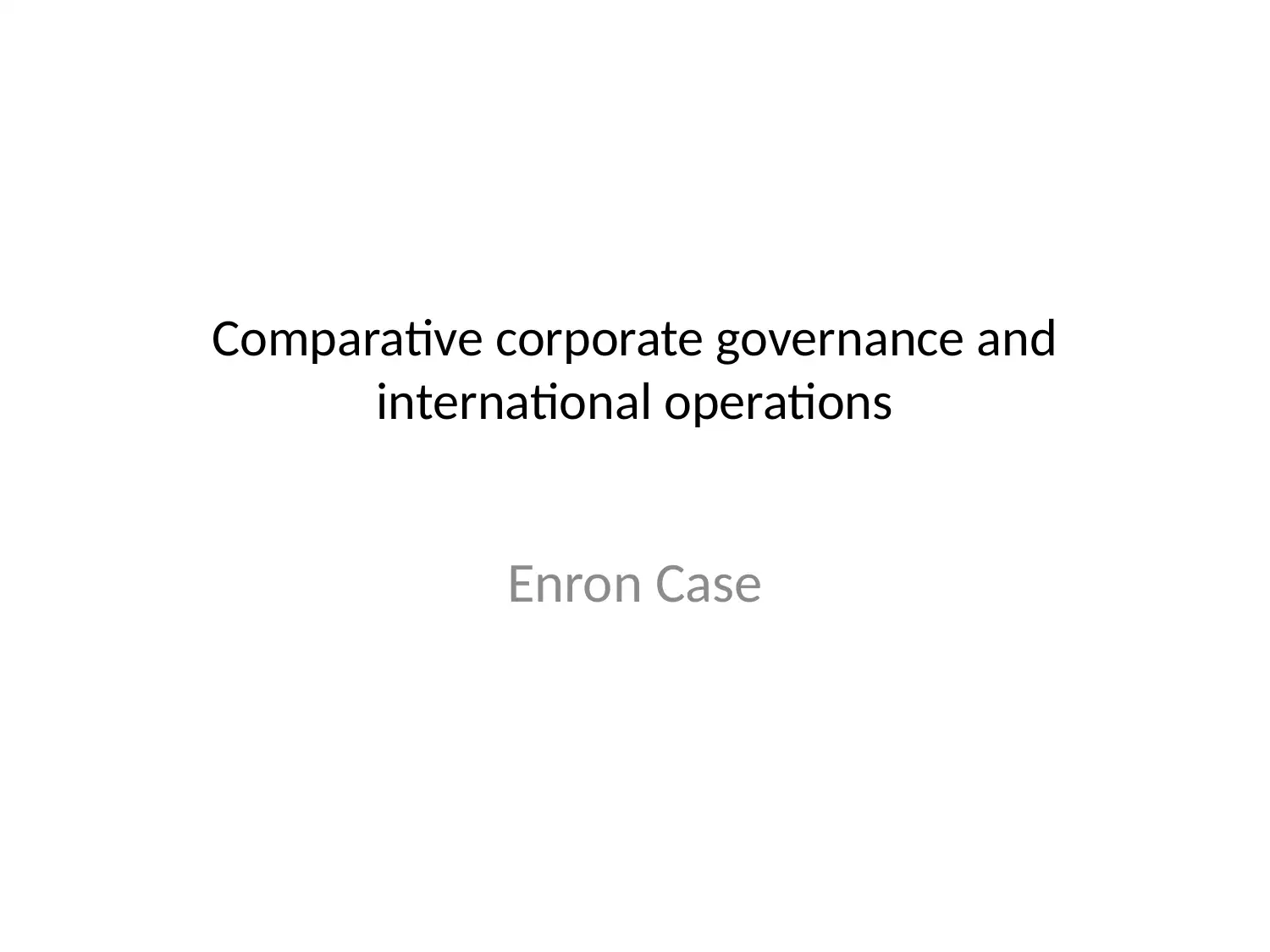
Comparative corporate governance and
international operations
Enron Case
international operations
Enron Case
Secure Best Marks with AI Grader
Need help grading? Try our AI Grader for instant feedback on your assignments.
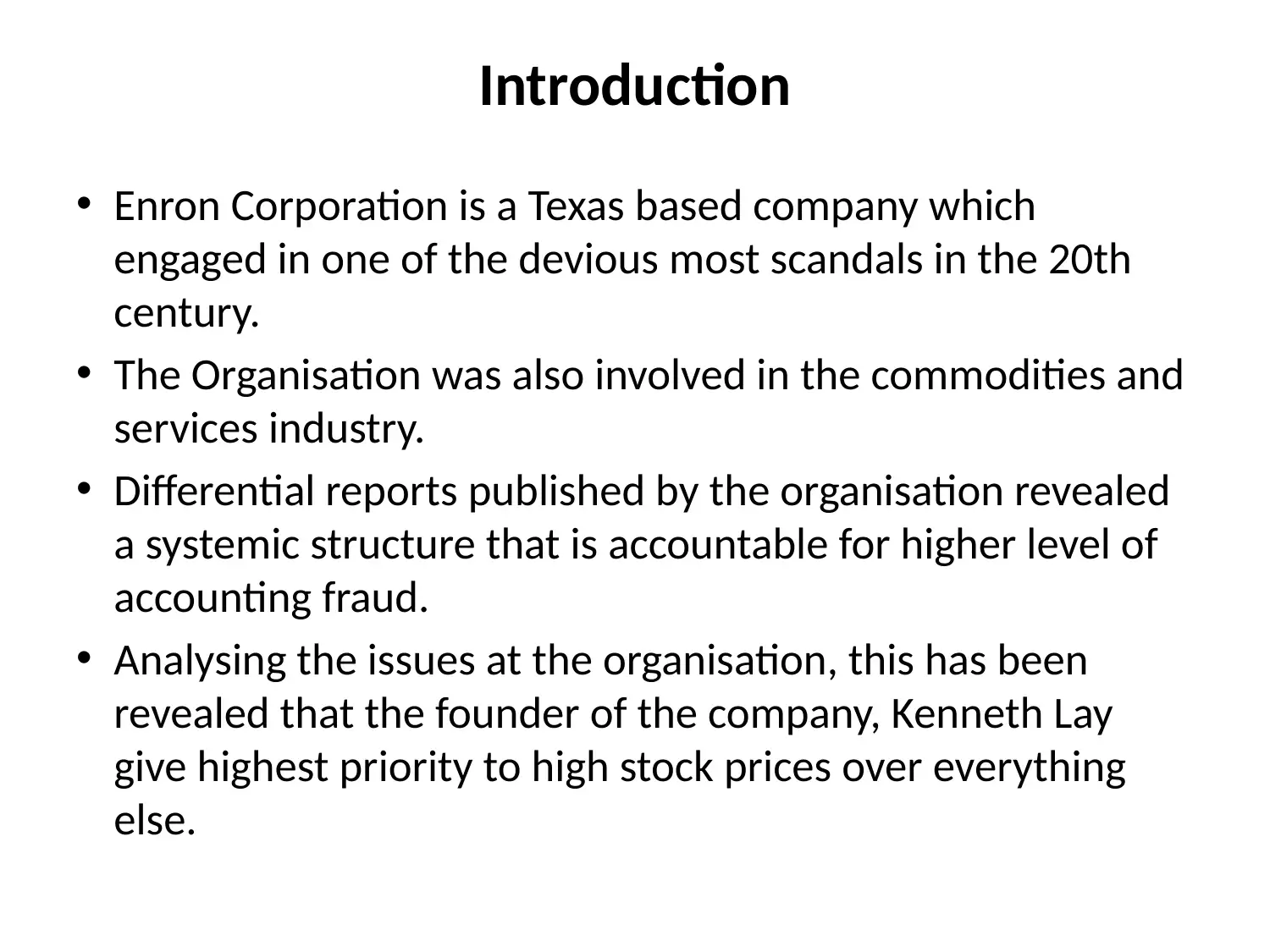
Introduction
• Enron Corporation is a Texas based company which
engaged in one of the devious most scandals in the 20th
century.
• The Organisation was also involved in the commodities and
services industry.
• Differential reports published by the organisation revealed
a systemic structure that is accountable for higher level of
accounting fraud.
• Analysing the issues at the organisation, this has been
revealed that the founder of the company, Kenneth Lay
give highest priority to high stock prices over everything
else.
• Enron Corporation is a Texas based company which
engaged in one of the devious most scandals in the 20th
century.
• The Organisation was also involved in the commodities and
services industry.
• Differential reports published by the organisation revealed
a systemic structure that is accountable for higher level of
accounting fraud.
• Analysing the issues at the organisation, this has been
revealed that the founder of the company, Kenneth Lay
give highest priority to high stock prices over everything
else.
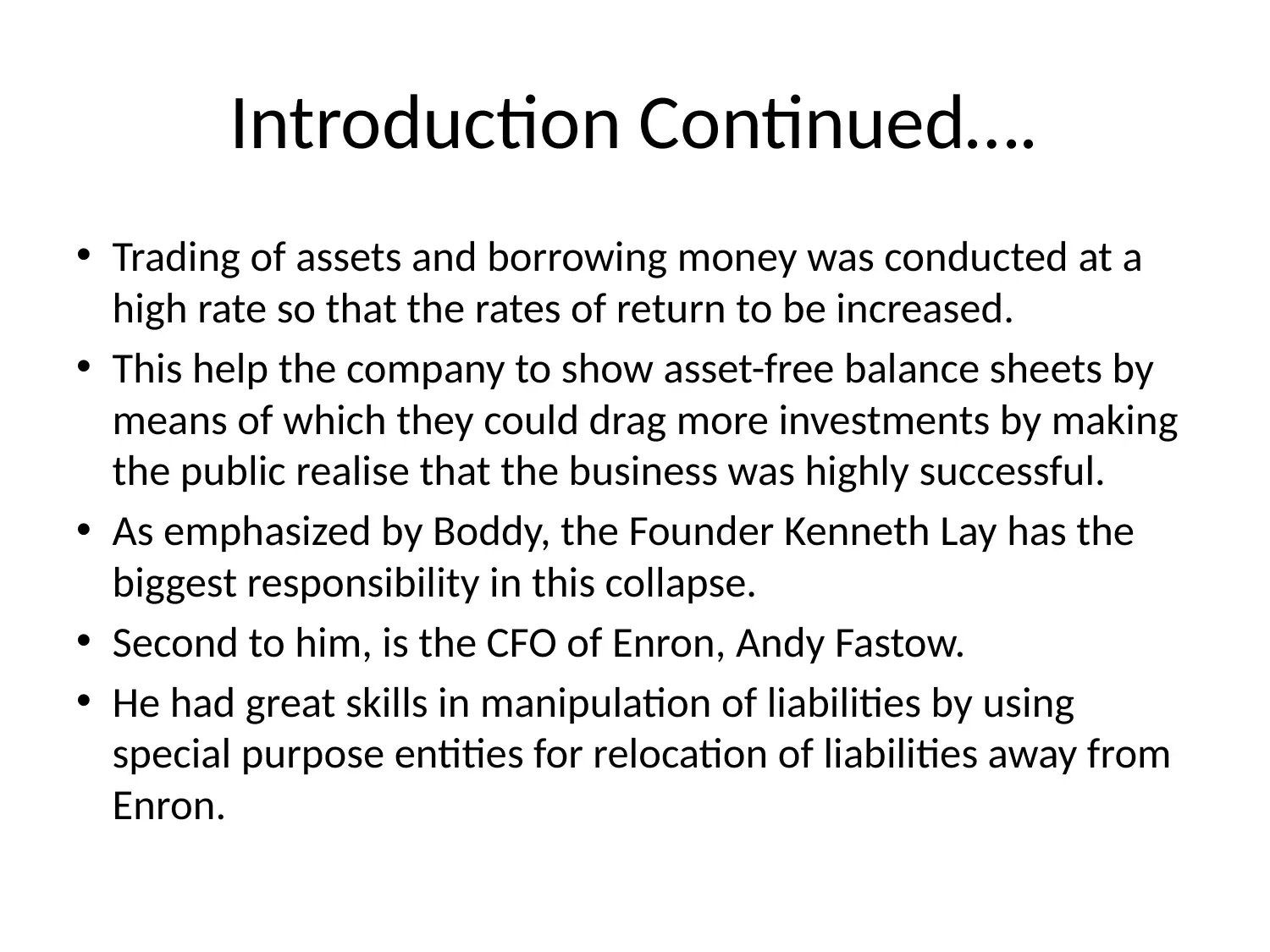
Introduction Continued….
• Trading of assets and borrowing money was conducted at a
high rate so that the rates of return to be increased.
• This help the company to show asset-free balance sheets by
means of which they could drag more investments by making
the public realise that the business was highly successful.
• As emphasized by Boddy, the Founder Kenneth Lay has the
biggest responsibility in this collapse.
• Second to him, is the CFO of Enron, Andy Fastow.
• He had great skills in manipulation of liabilities by using
special purpose entities for relocation of liabilities away from
Enron.
• Trading of assets and borrowing money was conducted at a
high rate so that the rates of return to be increased.
• This help the company to show asset-free balance sheets by
means of which they could drag more investments by making
the public realise that the business was highly successful.
• As emphasized by Boddy, the Founder Kenneth Lay has the
biggest responsibility in this collapse.
• Second to him, is the CFO of Enron, Andy Fastow.
• He had great skills in manipulation of liabilities by using
special purpose entities for relocation of liabilities away from
Enron.
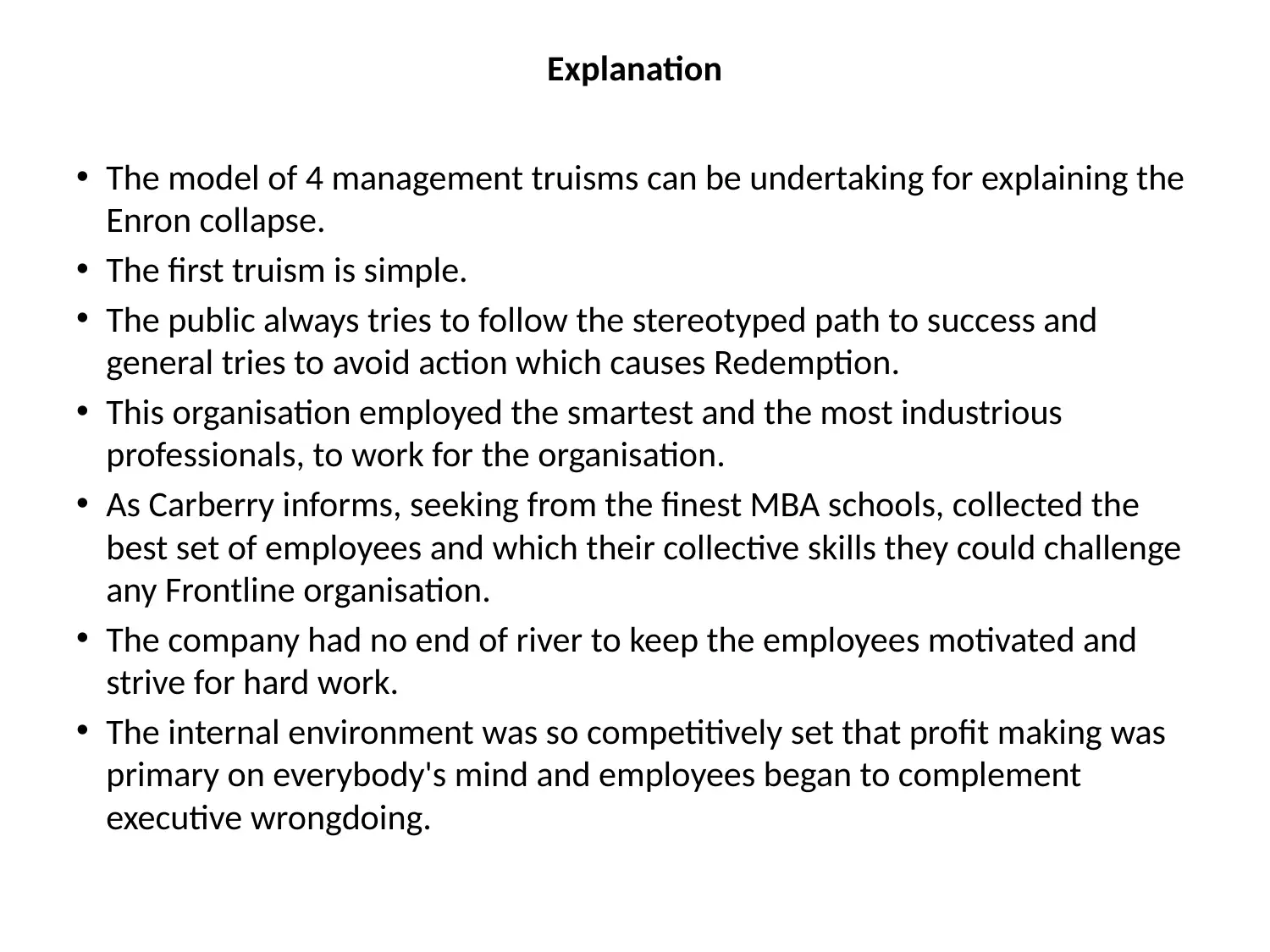
Explanation
• The model of 4 management truisms can be undertaking for explaining the
Enron collapse.
• The first truism is simple.
• The public always tries to follow the stereotyped path to success and
general tries to avoid action which causes Redemption.
• This organisation employed the smartest and the most industrious
professionals, to work for the organisation.
• As Carberry informs, seeking from the finest MBA schools, collected the
best set of employees and which their collective skills they could challenge
any Frontline organisation.
• The company had no end of river to keep the employees motivated and
strive for hard work.
• The internal environment was so competitively set that profit making was
primary on everybody's mind and employees began to complement
executive wrongdoing.
• The model of 4 management truisms can be undertaking for explaining the
Enron collapse.
• The first truism is simple.
• The public always tries to follow the stereotyped path to success and
general tries to avoid action which causes Redemption.
• This organisation employed the smartest and the most industrious
professionals, to work for the organisation.
• As Carberry informs, seeking from the finest MBA schools, collected the
best set of employees and which their collective skills they could challenge
any Frontline organisation.
• The company had no end of river to keep the employees motivated and
strive for hard work.
• The internal environment was so competitively set that profit making was
primary on everybody's mind and employees began to complement
executive wrongdoing.
Secure Best Marks with AI Grader
Need help grading? Try our AI Grader for instant feedback on your assignments.
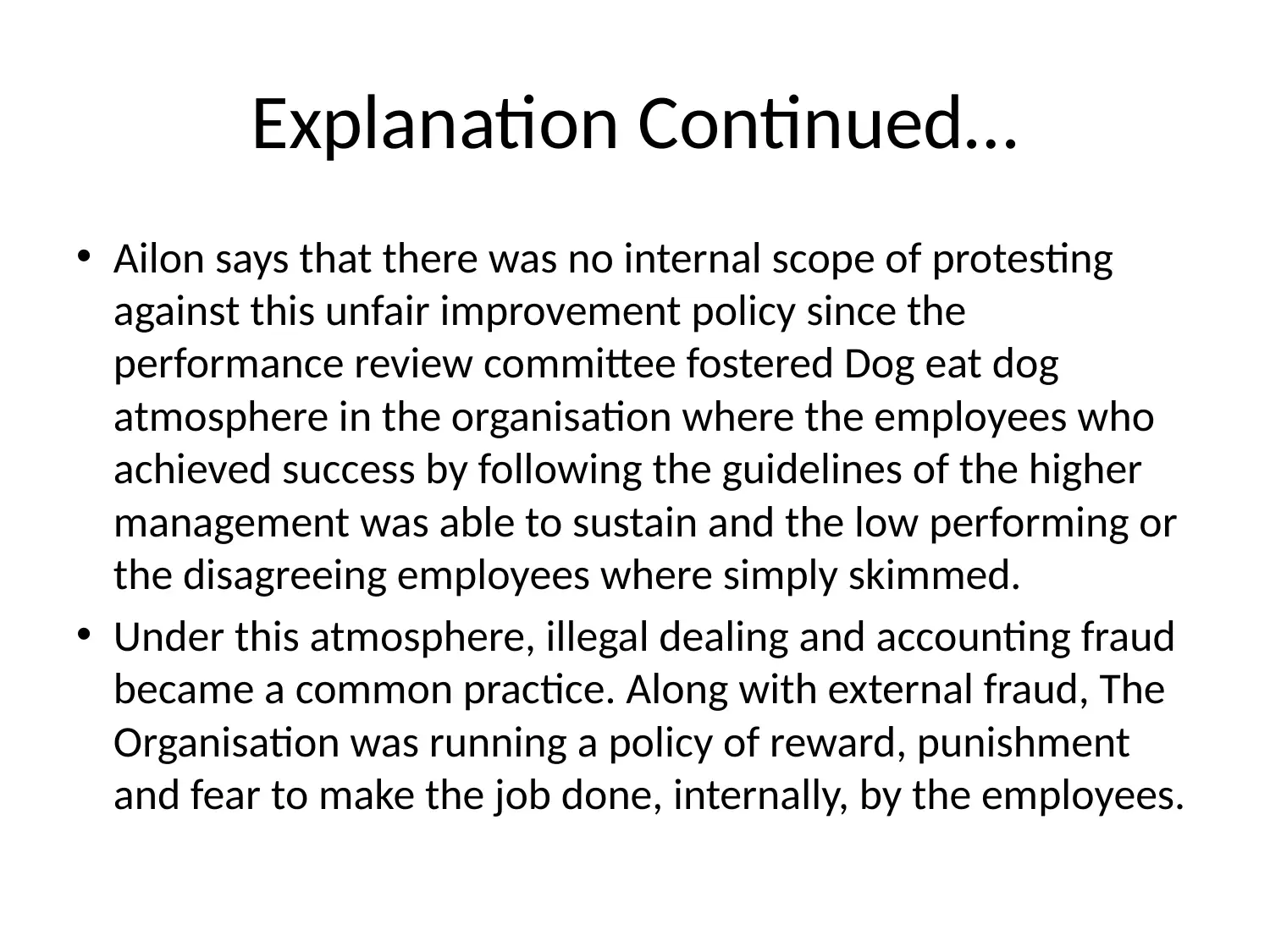
Explanation Continued…
• Ailon says that there was no internal scope of protesting
against this unfair improvement policy since the
performance review committee fostered Dog eat dog
atmosphere in the organisation where the employees who
achieved success by following the guidelines of the higher
management was able to sustain and the low performing or
the disagreeing employees where simply skimmed.
• Under this atmosphere, illegal dealing and accounting fraud
became a common practice. Along with external fraud, The
Organisation was running a policy of reward, punishment
and fear to make the job done, internally, by the employees.
• Ailon says that there was no internal scope of protesting
against this unfair improvement policy since the
performance review committee fostered Dog eat dog
atmosphere in the organisation where the employees who
achieved success by following the guidelines of the higher
management was able to sustain and the low performing or
the disagreeing employees where simply skimmed.
• Under this atmosphere, illegal dealing and accounting fraud
became a common practice. Along with external fraud, The
Organisation was running a policy of reward, punishment
and fear to make the job done, internally, by the employees.
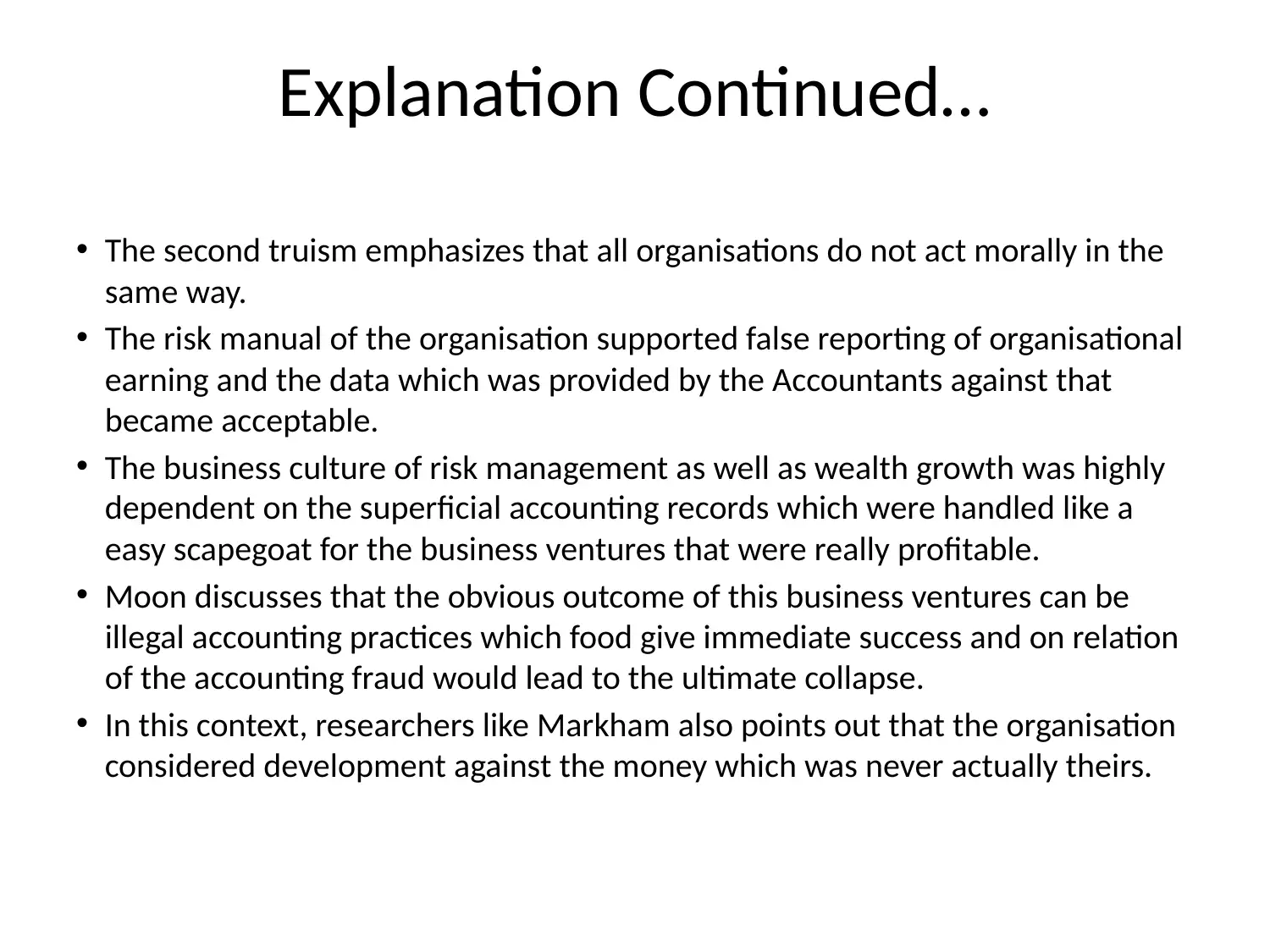
Explanation Continued…
• The second truism emphasizes that all organisations do not act morally in the
same way.
• The risk manual of the organisation supported false reporting of organisational
earning and the data which was provided by the Accountants against that
became acceptable.
• The business culture of risk management as well as wealth growth was highly
dependent on the superficial accounting records which were handled like a
easy scapegoat for the business ventures that were really profitable.
• Moon discusses that the obvious outcome of this business ventures can be
illegal accounting practices which food give immediate success and on relation
of the accounting fraud would lead to the ultimate collapse.
• In this context, researchers like Markham also points out that the organisation
considered development against the money which was never actually theirs.
• The second truism emphasizes that all organisations do not act morally in the
same way.
• The risk manual of the organisation supported false reporting of organisational
earning and the data which was provided by the Accountants against that
became acceptable.
• The business culture of risk management as well as wealth growth was highly
dependent on the superficial accounting records which were handled like a
easy scapegoat for the business ventures that were really profitable.
• Moon discusses that the obvious outcome of this business ventures can be
illegal accounting practices which food give immediate success and on relation
of the accounting fraud would lead to the ultimate collapse.
• In this context, researchers like Markham also points out that the organisation
considered development against the money which was never actually theirs.
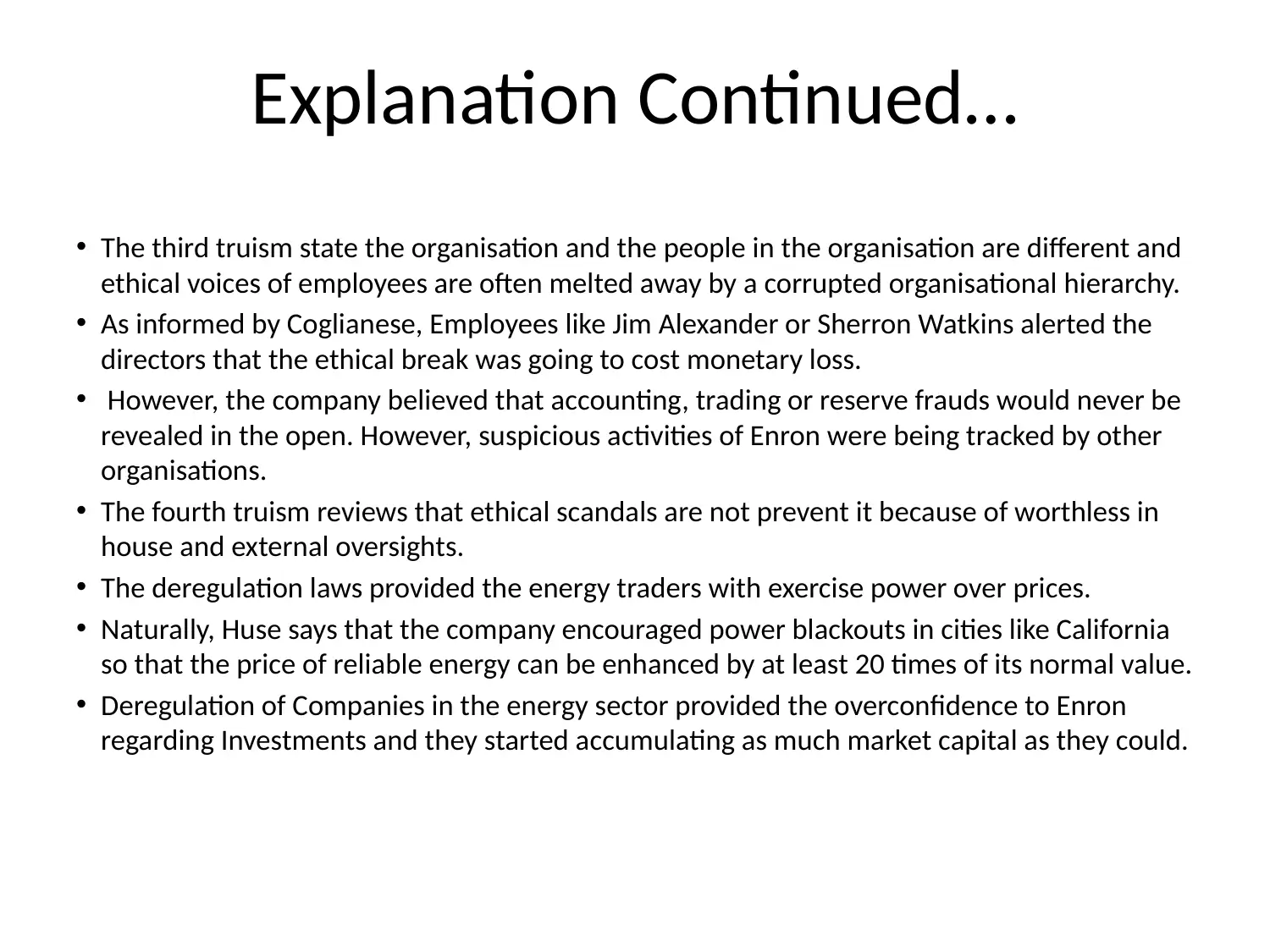
Explanation Continued…
• The third truism state the organisation and the people in the organisation are different and
ethical voices of employees are often melted away by a corrupted organisational hierarchy.
• As informed by Coglianese, Employees like Jim Alexander or Sherron Watkins alerted the
directors that the ethical break was going to cost monetary loss.
• However, the company believed that accounting, trading or reserve frauds would never be
revealed in the open. However, suspicious activities of Enron were being tracked by other
organisations.
• The fourth truism reviews that ethical scandals are not prevent it because of worthless in
house and external oversights.
• The deregulation laws provided the energy traders with exercise power over prices.
• Naturally, Huse says that the company encouraged power blackouts in cities like California
so that the price of reliable energy can be enhanced by at least 20 times of its normal value.
• Deregulation of Companies in the energy sector provided the overconfidence to Enron
regarding Investments and they started accumulating as much market capital as they could.
• The third truism state the organisation and the people in the organisation are different and
ethical voices of employees are often melted away by a corrupted organisational hierarchy.
• As informed by Coglianese, Employees like Jim Alexander or Sherron Watkins alerted the
directors that the ethical break was going to cost monetary loss.
• However, the company believed that accounting, trading or reserve frauds would never be
revealed in the open. However, suspicious activities of Enron were being tracked by other
organisations.
• The fourth truism reviews that ethical scandals are not prevent it because of worthless in
house and external oversights.
• The deregulation laws provided the energy traders with exercise power over prices.
• Naturally, Huse says that the company encouraged power blackouts in cities like California
so that the price of reliable energy can be enhanced by at least 20 times of its normal value.
• Deregulation of Companies in the energy sector provided the overconfidence to Enron
regarding Investments and they started accumulating as much market capital as they could.
Paraphrase This Document
Need a fresh take? Get an instant paraphrase of this document with our AI Paraphraser
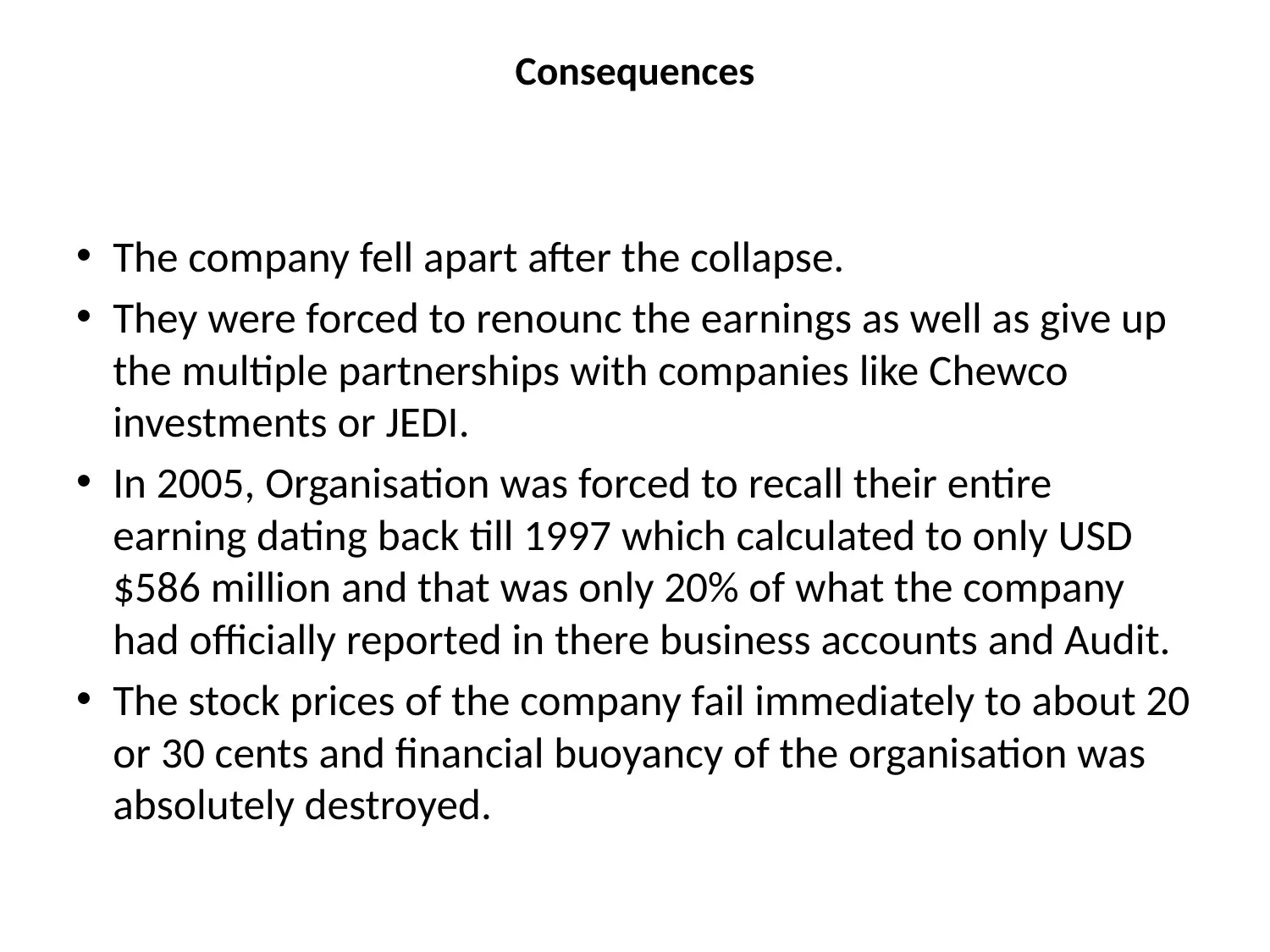
Consequences
• The company fell apart after the collapse.
• They were forced to renounc the earnings as well as give up
the multiple partnerships with companies like Chewco
investments or JEDI.
• In 2005, Organisation was forced to recall their entire
earning dating back till 1997 which calculated to only USD
$586 million and that was only 20% of what the company
had officially reported in there business accounts and Audit.
• The stock prices of the company fail immediately to about 20
or 30 cents and financial buoyancy of the organisation was
absolutely destroyed.
• The company fell apart after the collapse.
• They were forced to renounc the earnings as well as give up
the multiple partnerships with companies like Chewco
investments or JEDI.
• In 2005, Organisation was forced to recall their entire
earning dating back till 1997 which calculated to only USD
$586 million and that was only 20% of what the company
had officially reported in there business accounts and Audit.
• The stock prices of the company fail immediately to about 20
or 30 cents and financial buoyancy of the organisation was
absolutely destroyed.
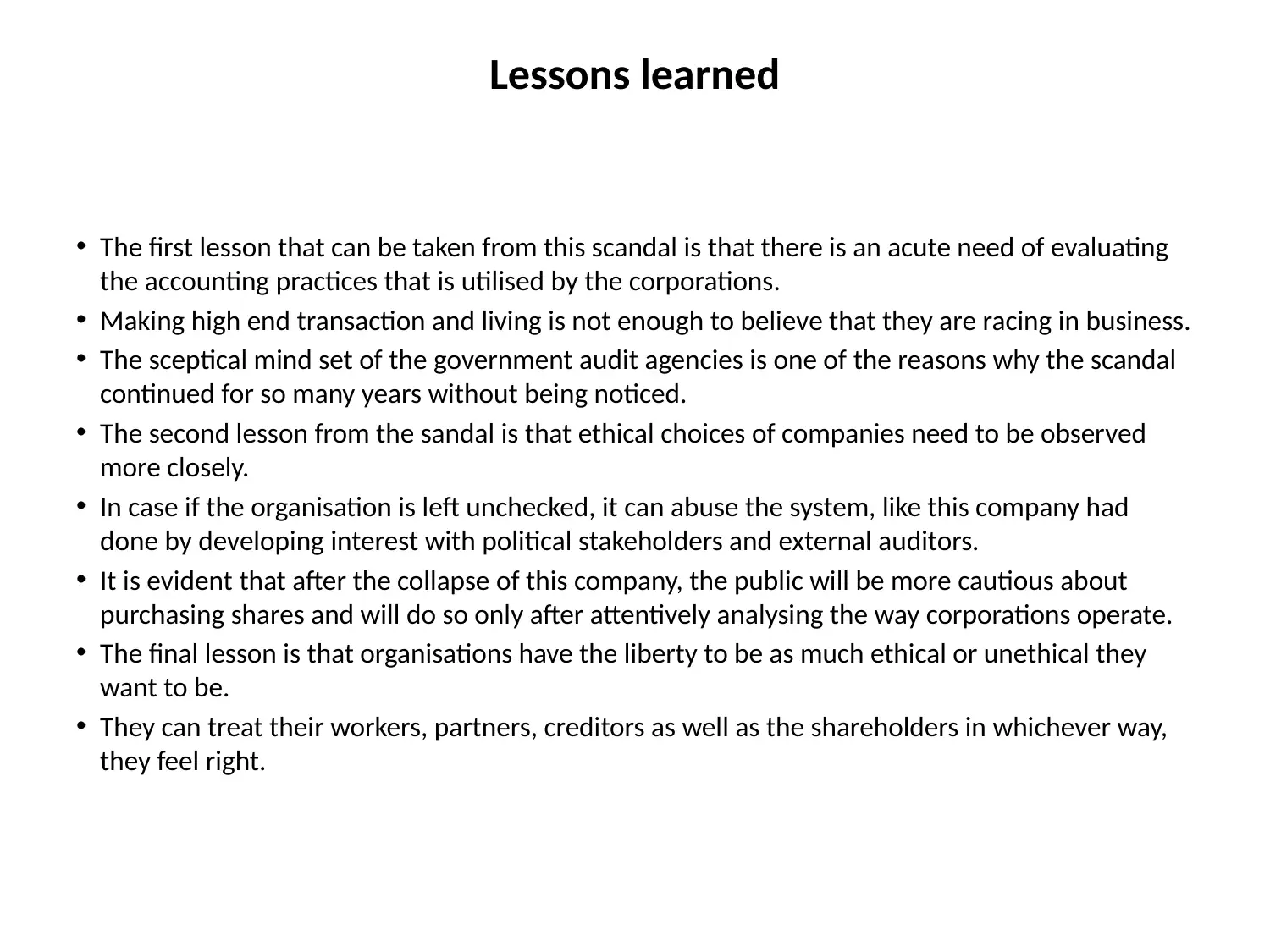
Lessons learned
• The first lesson that can be taken from this scandal is that there is an acute need of evaluating
the accounting practices that is utilised by the corporations.
• Making high end transaction and living is not enough to believe that they are racing in business.
• The sceptical mind set of the government audit agencies is one of the reasons why the scandal
continued for so many years without being noticed.
• The second lesson from the sandal is that ethical choices of companies need to be observed
more closely.
• In case if the organisation is left unchecked, it can abuse the system, like this company had
done by developing interest with political stakeholders and external auditors.
• It is evident that after the collapse of this company, the public will be more cautious about
purchasing shares and will do so only after attentively analysing the way corporations operate.
• The final lesson is that organisations have the liberty to be as much ethical or unethical they
want to be.
• They can treat their workers, partners, creditors as well as the shareholders in whichever way,
they feel right.
• The first lesson that can be taken from this scandal is that there is an acute need of evaluating
the accounting practices that is utilised by the corporations.
• Making high end transaction and living is not enough to believe that they are racing in business.
• The sceptical mind set of the government audit agencies is one of the reasons why the scandal
continued for so many years without being noticed.
• The second lesson from the sandal is that ethical choices of companies need to be observed
more closely.
• In case if the organisation is left unchecked, it can abuse the system, like this company had
done by developing interest with political stakeholders and external auditors.
• It is evident that after the collapse of this company, the public will be more cautious about
purchasing shares and will do so only after attentively analysing the way corporations operate.
• The final lesson is that organisations have the liberty to be as much ethical or unethical they
want to be.
• They can treat their workers, partners, creditors as well as the shareholders in whichever way,
they feel right.
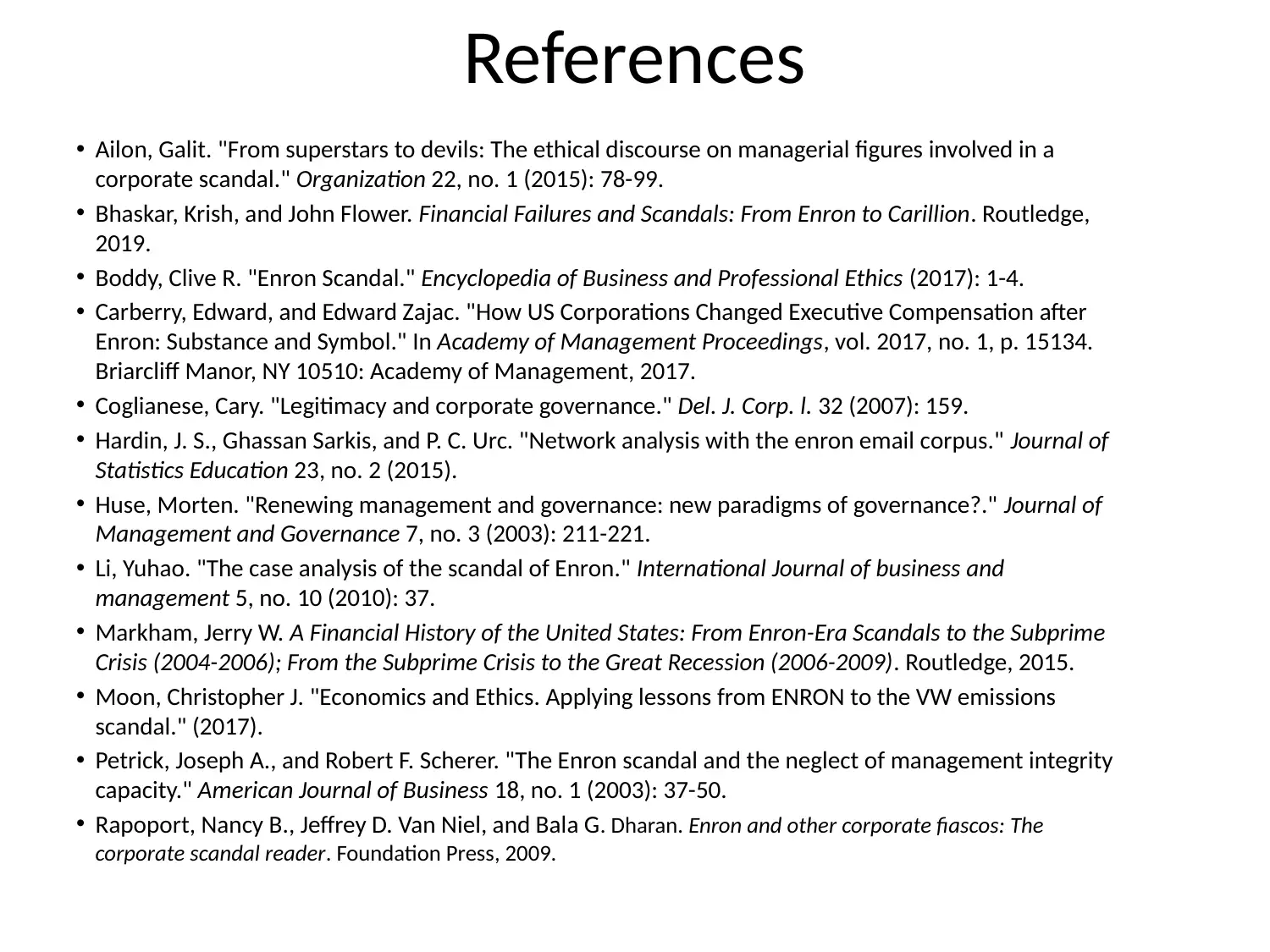
References
• Ailon, Galit. "From superstars to devils: The ethical discourse on managerial figures involved in a
corporate scandal." Organization 22, no. 1 (2015): 78-99.
• Bhaskar, Krish, and John Flower. Financial Failures and Scandals: From Enron to Carillion. Routledge,
2019.
• Boddy, Clive R. "Enron Scandal." Encyclopedia of Business and Professional Ethics (2017): 1-4.
• Carberry, Edward, and Edward Zajac. "How US Corporations Changed Executive Compensation after
Enron: Substance and Symbol." In Academy of Management Proceedings, vol. 2017, no. 1, p. 15134.
Briarcliff Manor, NY 10510: Academy of Management, 2017.
• Coglianese, Cary. "Legitimacy and corporate governance." Del. J. Corp. l. 32 (2007): 159.
• Hardin, J. S., Ghassan Sarkis, and P. C. Urc. "Network analysis with the enron email corpus." Journal of
Statistics Education 23, no. 2 (2015).
• Huse, Morten. "Renewing management and governance: new paradigms of governance?." Journal of
Management and Governance 7, no. 3 (2003): 211-221.
• Li, Yuhao. "The case analysis of the scandal of Enron." International Journal of business and
management 5, no. 10 (2010): 37.
• Markham, Jerry W. A Financial History of the United States: From Enron-Era Scandals to the Subprime
Crisis (2004-2006); From the Subprime Crisis to the Great Recession (2006-2009). Routledge, 2015.
• Moon, Christopher J. "Economics and Ethics. Applying lessons from ENRON to the VW emissions
scandal." (2017).
• Petrick, Joseph A., and Robert F. Scherer. "The Enron scandal and the neglect of management integrity
capacity." American Journal of Business 18, no. 1 (2003): 37-50.
• Rapoport, Nancy B., Jeffrey D. Van Niel, and Bala G. Dharan. Enron and other corporate fiascos: The
corporate scandal reader. Foundation Press, 2009.
• Ailon, Galit. "From superstars to devils: The ethical discourse on managerial figures involved in a
corporate scandal." Organization 22, no. 1 (2015): 78-99.
• Bhaskar, Krish, and John Flower. Financial Failures and Scandals: From Enron to Carillion. Routledge,
2019.
• Boddy, Clive R. "Enron Scandal." Encyclopedia of Business and Professional Ethics (2017): 1-4.
• Carberry, Edward, and Edward Zajac. "How US Corporations Changed Executive Compensation after
Enron: Substance and Symbol." In Academy of Management Proceedings, vol. 2017, no. 1, p. 15134.
Briarcliff Manor, NY 10510: Academy of Management, 2017.
• Coglianese, Cary. "Legitimacy and corporate governance." Del. J. Corp. l. 32 (2007): 159.
• Hardin, J. S., Ghassan Sarkis, and P. C. Urc. "Network analysis with the enron email corpus." Journal of
Statistics Education 23, no. 2 (2015).
• Huse, Morten. "Renewing management and governance: new paradigms of governance?." Journal of
Management and Governance 7, no. 3 (2003): 211-221.
• Li, Yuhao. "The case analysis of the scandal of Enron." International Journal of business and
management 5, no. 10 (2010): 37.
• Markham, Jerry W. A Financial History of the United States: From Enron-Era Scandals to the Subprime
Crisis (2004-2006); From the Subprime Crisis to the Great Recession (2006-2009). Routledge, 2015.
• Moon, Christopher J. "Economics and Ethics. Applying lessons from ENRON to the VW emissions
scandal." (2017).
• Petrick, Joseph A., and Robert F. Scherer. "The Enron scandal and the neglect of management integrity
capacity." American Journal of Business 18, no. 1 (2003): 37-50.
• Rapoport, Nancy B., Jeffrey D. Van Niel, and Bala G. Dharan. Enron and other corporate fiascos: The
corporate scandal reader. Foundation Press, 2009.
Secure Best Marks with AI Grader
Need help grading? Try our AI Grader for instant feedback on your assignments.
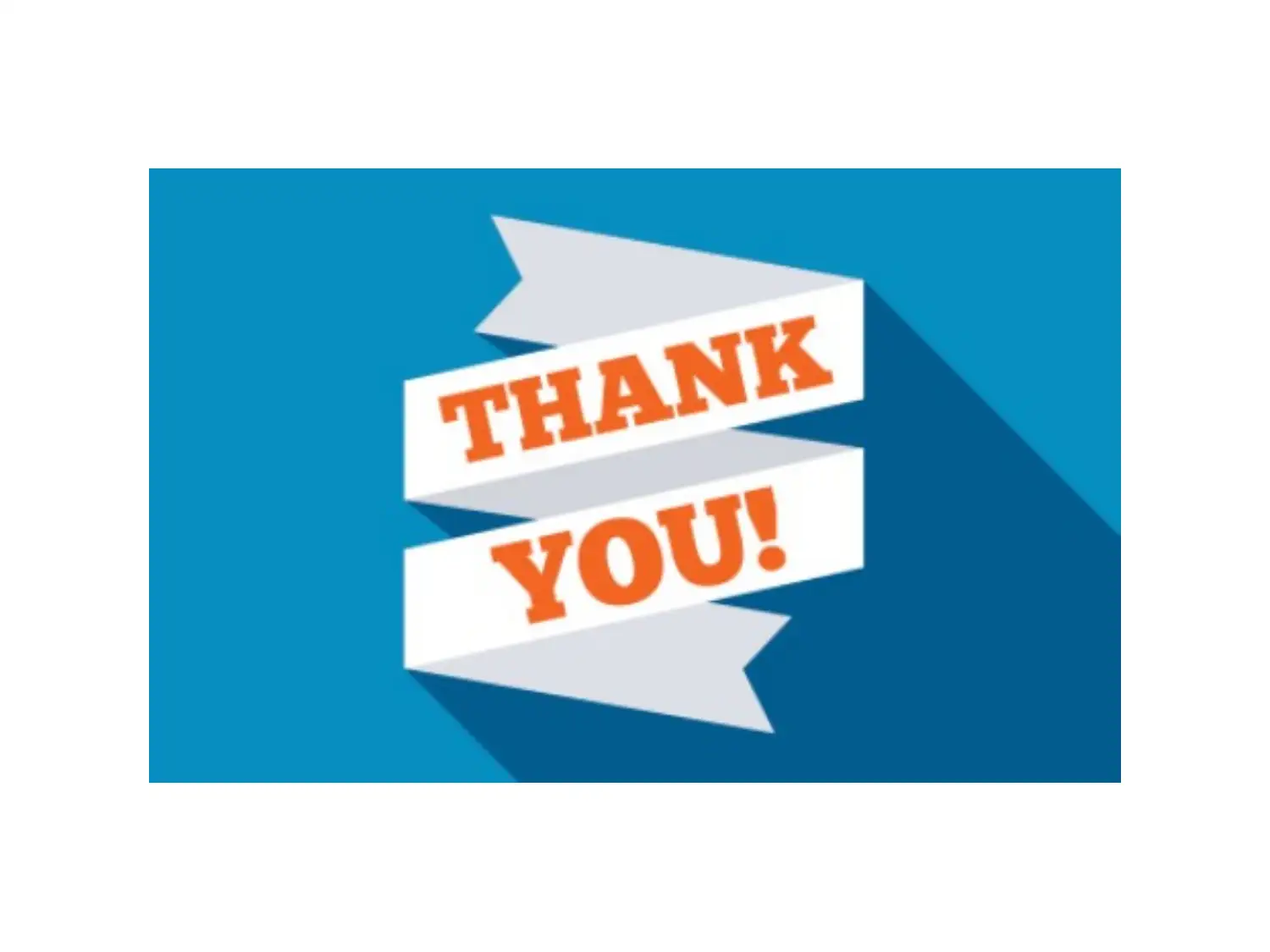
1 out of 11
Your All-in-One AI-Powered Toolkit for Academic Success.
+13062052269
info@desklib.com
Available 24*7 on WhatsApp / Email
![[object Object]](/_next/static/media/star-bottom.7253800d.svg)
Unlock your academic potential
© 2024 | Zucol Services PVT LTD | All rights reserved.

